 |
| This page last updated 14th July 2009 |
The 110 Ships, Their Fate |
| Ship | Pendants | Builder | Laid Down | Launched | Completed | Service | Disposal and Fate |
|---|---|---|---|---|---|---|---|
| MELITA Ex-USN AM332 |
J289 (M289) |
Tor. | 02.09.42 | 08.12.42 | 20.12.43 | 6MSF RNVR | 1959 B.U. at Llanelli |
| MICHAEL | J444 (M444) | Tor. | 25.05.44 | 20.09.44 | 21.05.45 | 7MSF 10MSF 11MSF 6MSF (FE) |
1956 B.U. at Bo'ness |
| MINSTREL | J445 | Tor. | 27.06.44 | 05.10.44 | 09.06.45 | 10MSF 7MSF 11MSF | 1947 Trans. Thailand ren. PHOSAMTON 6MSF (FE); 1990 sea-going training ship |
| MOON Ex-RCN Mimico |
J329 (M329) | Tor. | 23.03.43 | 02.09.43 | 06.07.44 | 8MSF Pal.P. | 1957 B.U. at Gateshead |
| MUTINE | J227 (M227) | H/W | 24.11.41 | 10.10.42 | 26.02.43 | 12MSF Pal.P Vernon |
1967 B.U. at Barrow |
| MYRMIDON |
J454 (M454) | Tor. | 19.07.44 | 21.10.44 | 09.07.45 | 3MSF | 1958 B.U. at Briton Ferry |
| MYSTIC | J455 (M455) | Tor. | 09.08.44 | 11.11.44 | 02.08.45 | 3MSF | 1958 B.U. at Llanelli |
| NERISSA | J456 (M456) | Tor. | 30.08.44 | 25.11.44 | 28.08.45 | 3MSF | 1960 B.U. at Llanelli |
| NIGER Ex-DISDAIN |
J442 (M73) |
Lob. | 05.11.44 | 01.05.45 | 21.09.45 | HQ/MS E Indies (11MSF) | 1966 B.U. at Silloth |
| OCTAVIA Ex-USN AM333 |
J290 |
Tor. | 27.09.42 | 31.12.42 | 24.02.44 | 5MSF Pal.P. |
1950 B.U. at Gateshead |
| ONYX | J221 (M221) | H/W | 24.11.41 | 27.10.42 | 26.03.43 | 18MSF 3MSF |
1967 B.U. at Inverkeithing |
| ORCADIA |
J462 (M462) |
P.A. | 19.11.43 | 08.08.44 | 11.08.45 | 4MSF | 1958 B.U. at Briton Ferry |
| ORESTES | J277 (M277) |
Lob. | 27.03.42 | 25.11.42 | 10.04.43 | 18MSF 5FPS |
1961 B.U. at Troon |
| OSSORY | J463 (M463) | P.A. | 20.11.43 | 03.10.44 | 03.10.45 | 4MSF FPF | 1959 B.U. at Troon |
| PELORUS | J291 | Lob. | 08.10.42 | 18.06.43 | 07.10.43 | 7MSF 6MSF | 1947 Tansferred to South Africa ren. PIETERMARITZBURG; 1982 Accommodation ship at Simonstown |
| PERSIAN Ex-USN AM334 |
J347 | Tor. | 08.10.42 | 22.02.43 | 12.11.43 | 7MSF 6MSF | 1946 Returned control USN; 1948 Sold mercantile ren. Kikiades/Polikos; 196? scrapped |
 |
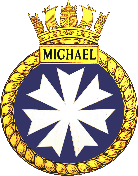 |
 |
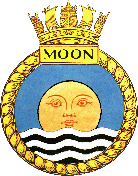 |
| MELITA | MICHAEL | MINSTREL | MOON |
| (Latin: honey-coloured). Roman name for Malta. The sword signifies St Paul who was shipwrecked there. (1942). Blue; in front of a sword erect point downwards proper pommel and hilt gold a Maltese Cross white. | From the Order of St Michael and St George, which dates from 1350. (1946). Blue; a seven-armed Maltese Cross white. | A mediaeval singer or poet. (1945). Blue; a lyre gold stringed white. | The brightness of the moon at sea contrasts with the apparent blackness of the water. (1944). Blue; issuant from water in base barry wavy of six white and black a moon in her complement gold. |
 |
 |
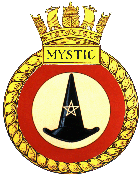 |
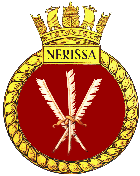 |
| MUTINE | MYRMIDON | MYSTIC | NERISSA |
| A French prize taken in 1797 by boats led by Lieutenant Hardy (later Captain) whose Crest is shown here. His action was rewarded by a promotion. (1942). White; a dragon’s head erased annodated proper. | Savage soldiery led by Achilles at the Siege of Troy. The name is interpreted from a word meaning ‘ant’ in Greek. (1945). Red; the head of a Greek soldier the helmet embossed with an ant on a roundel all gold. |
Occult or symbolic. (1946). Red; on a bezant a wizard’s hat black charged with a pentacle gold. | Portia’s servant in the ‘Merchant of Venice’. (1947). Red; three quill pens two in saltire and one in pale white nowed with a riband gold. |
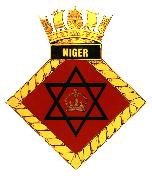 |
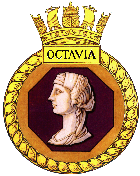 |
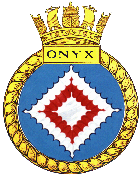 |
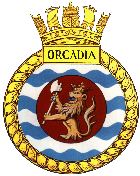 |
| NIGER | OCTAVIA | ONYX | ORCADIA |
| A river in West Africa. From the Colonial Badge. (1945). Red; within two interlaced triangles green the Royal crown gold. Nec timeo nec sperno: I neither fear nor despise |
Sister of Octavian Augustus Caesar; the purple of Roman nobility. (1944). Gold; upon an octagon purple the head of Octavia couped at the neck gold. | A semi-precious stone of varying colour. Also a single ship action of January 1809. (1942). Blue; upon a lozenge engrailed white a lozenge engrailed red charged with a like lozenge also white. | The ancient name for Orkney. From the Royal Arms of Norway, to whom the islands once belonged. (1946). Barry wavy of nine white and blue; on a torteau a demi-lion erased and ducally crowned gold holding in both paws an axe silver. |
 |
 |
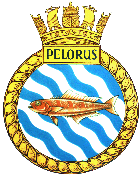 |
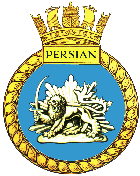 |
| ORESTES | OSSORY | PELORUS | PERSIAN |
| King Agamemnon had been murdered. His son, Orestes, obtained vengeance by killing the attackers - his mother Clytemnestra and her lover, Aegisthus. (“Aegis” is Greek for goatskin). (Ship adopted by Egham, Surrey). (1942). White; a goat’s head erased black armed gold pierced through the neck by a sword fesswise red pommel and hilt black. | The Duke of Ossory (1634-1680) fought at the Battle of Solebay under the Duke of York in 1672. (1946). Blue; five ostrich feathers white enfiled by a ducal coronet gold. | The Pilot fish. Also the ancient name for Cape Faro, Sicily. (1945). Bendy wavy white and blue; a pilot fish naiant red. | The lion of Judah. The country later known as Iran. (1943). Blue; on a mount in front of the rising sun a lion passant guardant holding in the dexter paw a curved sword all gold. |
 |
 |
|
| Last Page Badge Page 3 |
THIS IS BADGE PAGE 4 Back to Badges Index Page |
Next Page Badge Page 5 |
Return to top